| Proto-Indo-European kinship |   |
Linguistic paleontology is the use of reconstructed vocabulary to shed light on the society — its culture, its location — associated with a particular proto-language.
A large number of kinship terms have been reconstructed. They are agreed in pointing to a society that was patriarchal, patrilocal (the bride leaving her household to join that of her husband’s family), and patrilineal (descent reckoned by the male line).
| *pəter- | "father" | *māter- | "mother" | |
| *awo- | "grandfather" | *awon- | "maternal uncle" | |
| *nepōt- | "nephew" / "grandson" | < | ("daughter's / sister's son") | |
| *bhrāter- | "brother; male in clan group" | *swesor- | "sister; female in clan group" | |
| *daiwer- | "husband's brother" | — | "wife's brother" | |
| *snus- | "daughter-in-law" / "bride" |
While there exist many special terms for relatives by marriage on the husband’s side, like *daiwer- "husband’s brother", fewer corresponding terms on the wife’s side can be reconstructed for the protolanguage. The terms vary from dialect to dialect, providing good evidence for patrilocal marriage in the original society. Similarly, the term for "daughter-in-law" came to mean "bride" in some branches, suggesting the perspective of the husband's family when the new bride arrives.

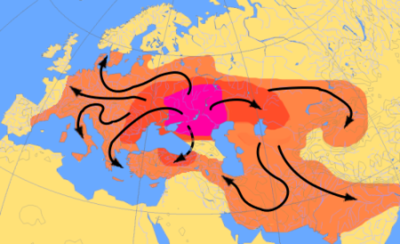
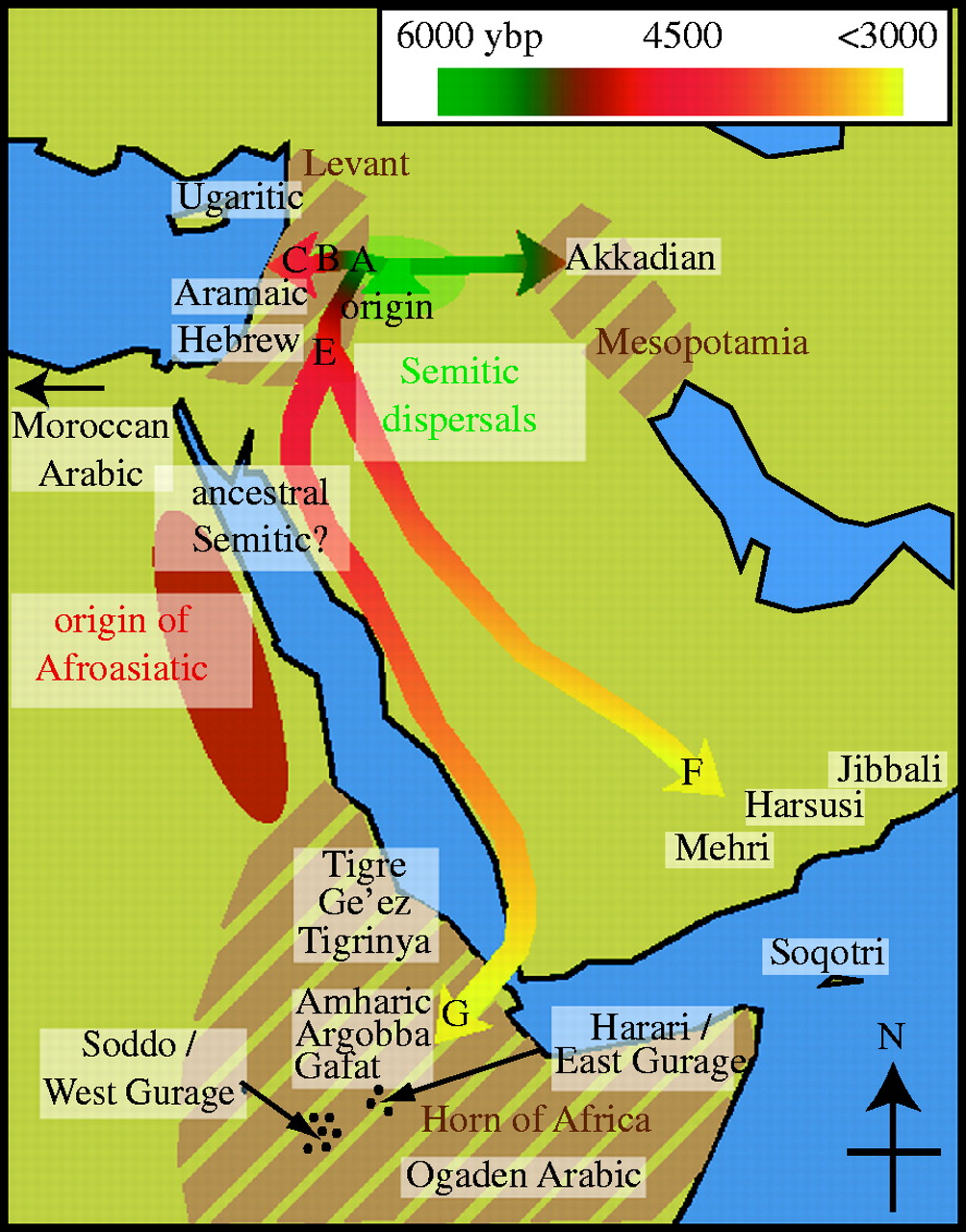 This
vocabulary is consistent with archaeological evidence for agriculture
and technology in the Middle East generally. The most common
This
vocabulary is consistent with archaeological evidence for agriculture
and technology in the Middle East generally. The most common
 The
first application of these principles to find the homeland of a
language family of the Americas was for Proto-Algonquian, in a
1967 article by Frank Siebert.
The
first application of these principles to find the homeland of a
language family of the Americas was for Proto-Algonquian, in a
1967 article by Frank Siebert.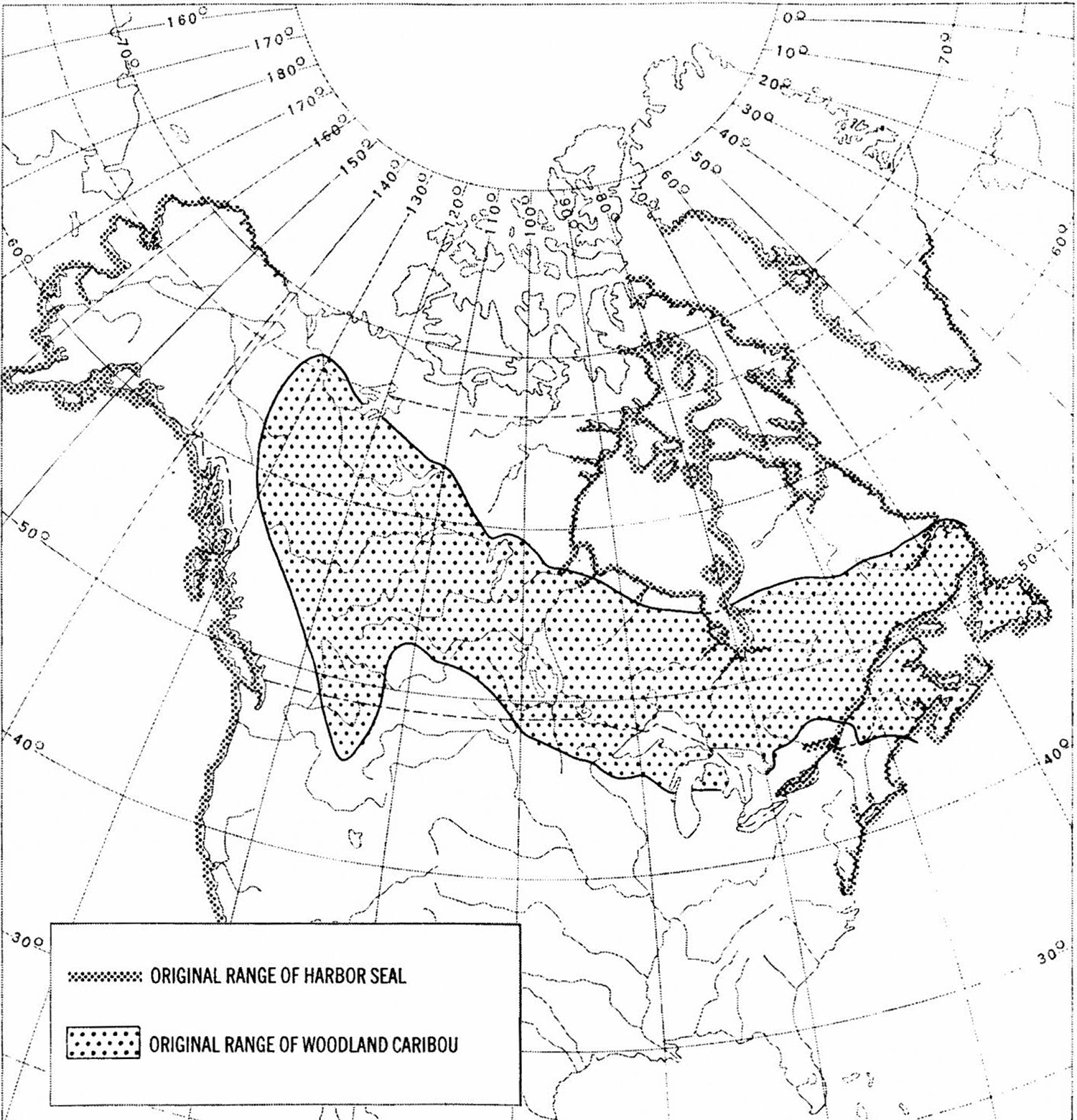 Siebert
compared the pre-contact distribution of animals such as the eastern
woodland caribou (found across Canada), and the harbor seal (on most of
the northern coastline but also in the St. Lawrence River that originates
in Lake Ontario). They can both be reconstructed for the proto-language.
Siebert
compared the pre-contact distribution of animals such as the eastern
woodland caribou (found across Canada), and the harbor seal (on most of
the northern coastline but also in the St. Lawrence River that originates
in Lake Ontario). They can both be reconstructed for the proto-language.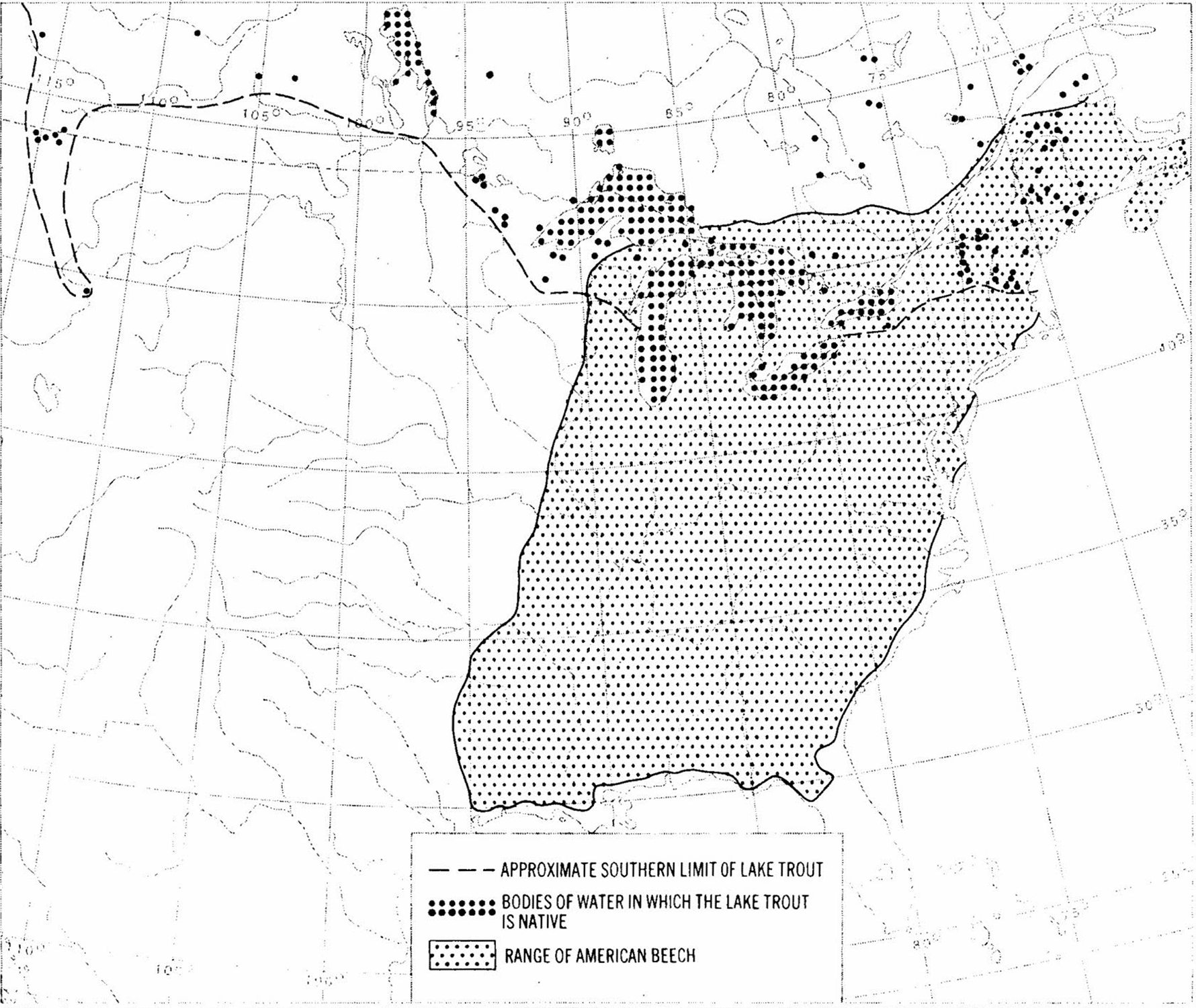 Two
other revealing terms are shown in this map, which intersect around
the Great Lakes and to the east.
Two
other revealing terms are shown in this map, which intersect around
the Great Lakes and to the east.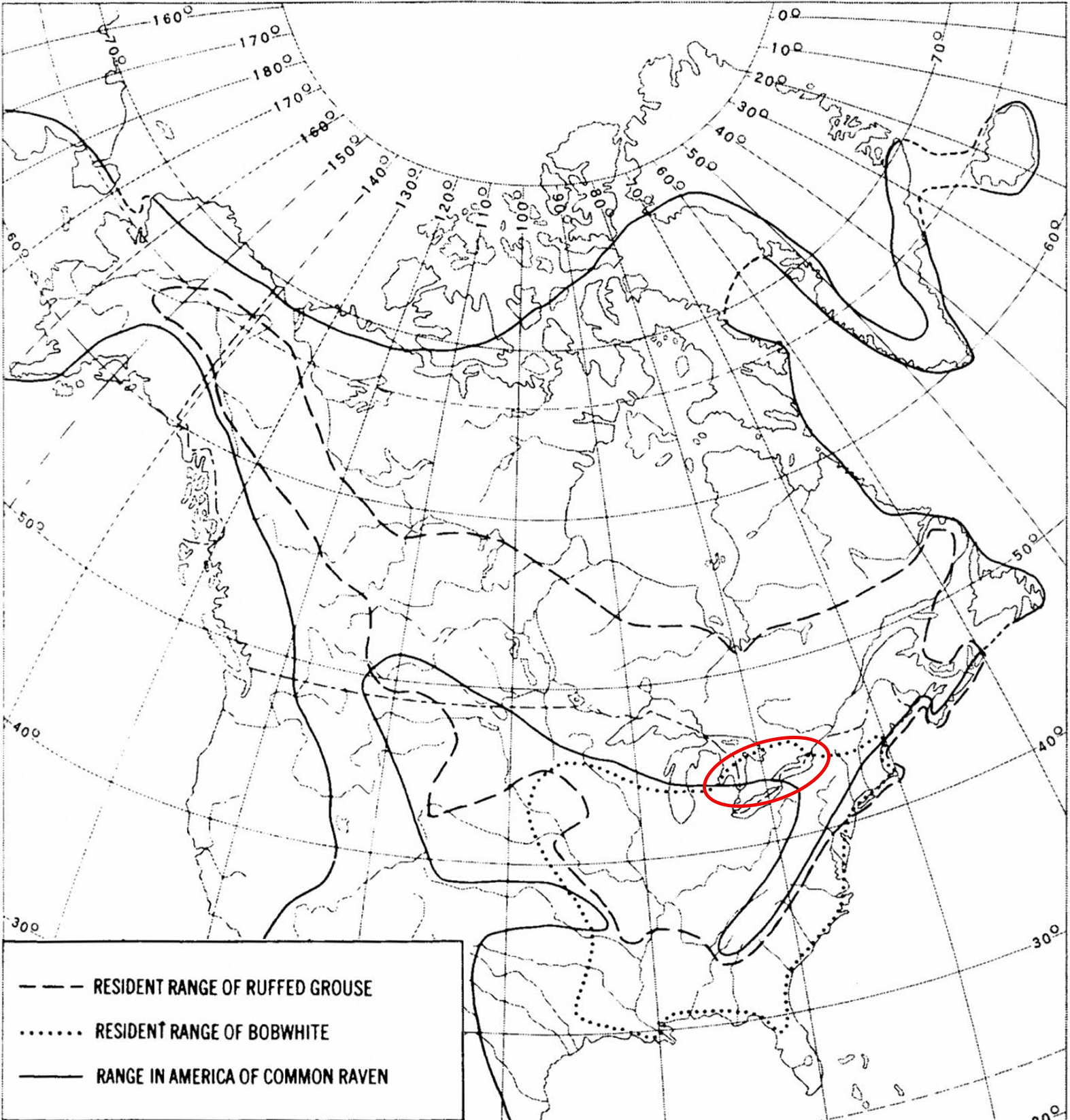 Similarly, the overlapping locations for these three birds point to a location around the Great Lakes.
Similarly, the overlapping locations for these three birds point to a location around the Great Lakes. Based on distributions such as these, Siebert places the homeland
at the eastern end of the
Based on distributions such as these, Siebert places the homeland
at the eastern end of the 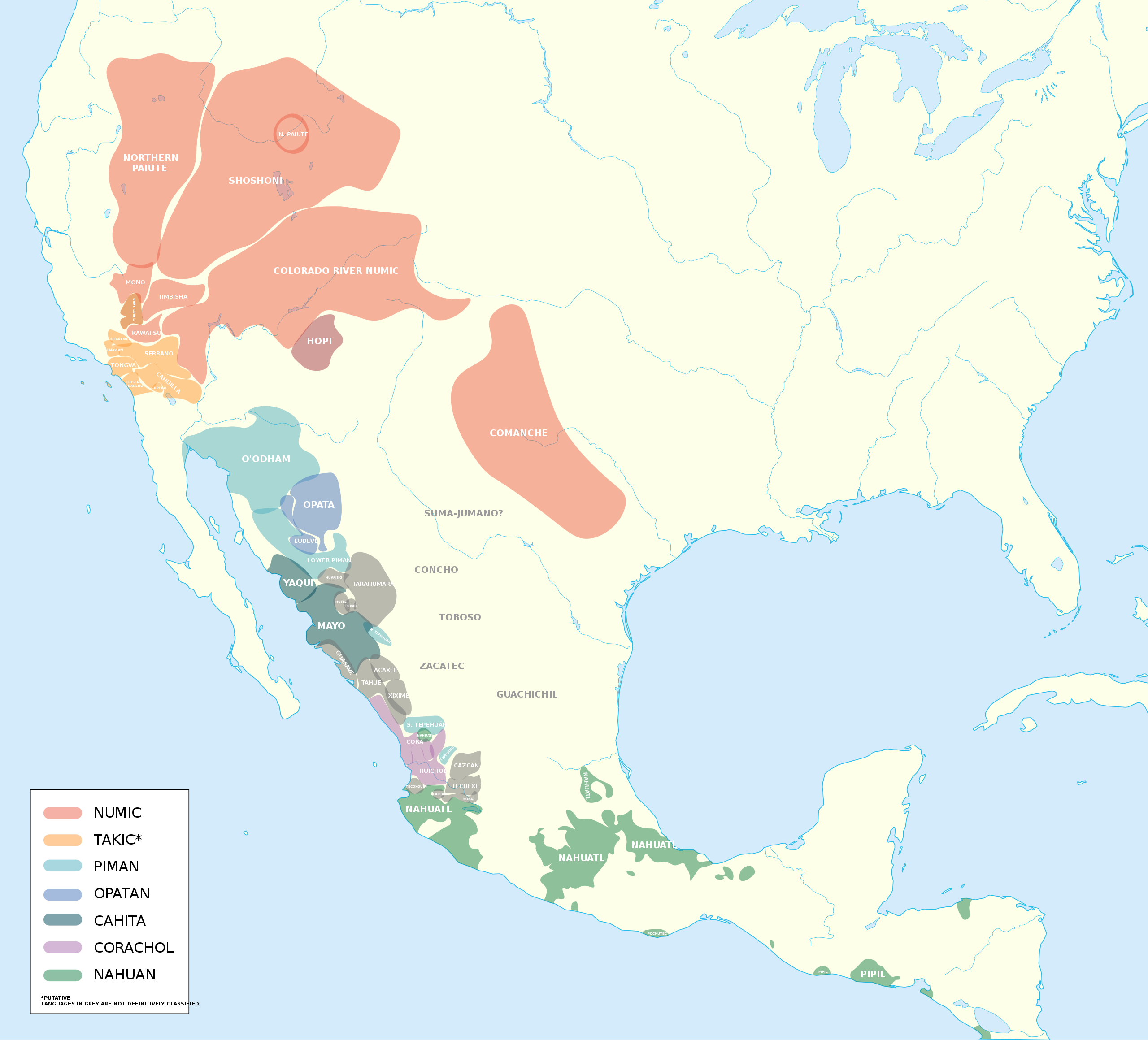 A thorough
discussion of similar reasoning is available for Uto-Aztecan. This family extends from the Northwest
all the way down to Central America. Given its wide distribution, one naturally wonders where
it originated: for example, did it start in the north with migration
southward, or vice versa?
A thorough
discussion of similar reasoning is available for Uto-Aztecan. This family extends from the Northwest
all the way down to Central America. Given its wide distribution, one naturally wonders where
it originated: for example, did it start in the north with migration
southward, or vice versa?  These
reconstructed terms are compatible with "a mixed woodland/grassland
setting, in proximity to montane forests." Notably lacking are words for
a hot desert, as inhabited by many of the descendant languages
— e.g., prickly pears tend to be at a higher altitude, in less
severe climates.
These
reconstructed terms are compatible with "a mixed woodland/grassland
setting, in proximity to montane forests." Notably lacking are words for
a hot desert, as inhabited by many of the descendant languages
— e.g., prickly pears tend to be at a higher altitude, in less
severe climates. 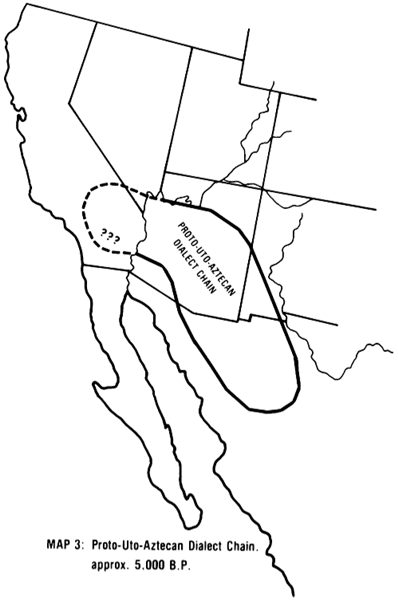 The
region shown here is a plausible location for a chain of dialects
before they fully differentiated into distinct languages.
The
region shown here is a plausible location for a chain of dialects
before they fully differentiated into distinct languages.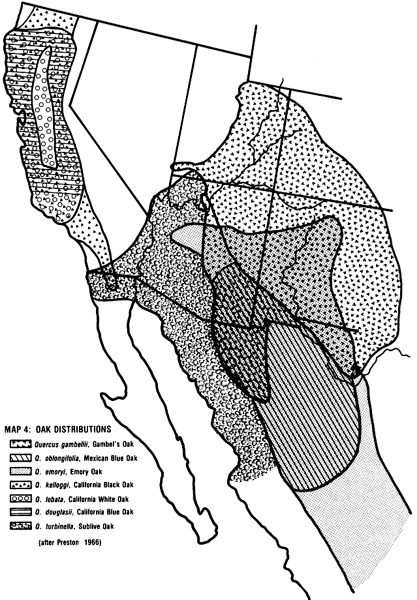 The
basic split into the northern and southern branches of the family
is reflected in distinct vocabulary items for a variety of flora
and fauna.
The
basic split into the northern and southern branches of the family
is reflected in distinct vocabulary items for a variety of flora
and fauna.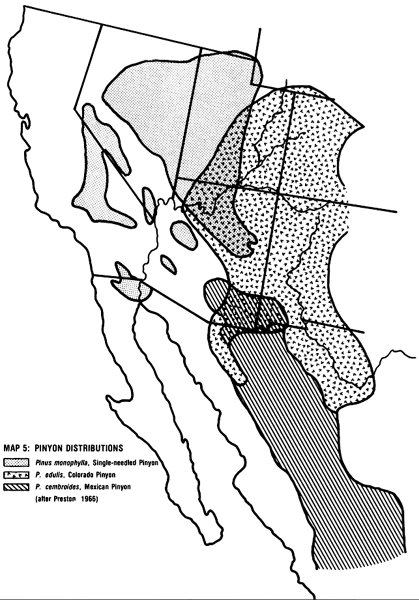 Similarly,
the term for
Similarly,
the term for 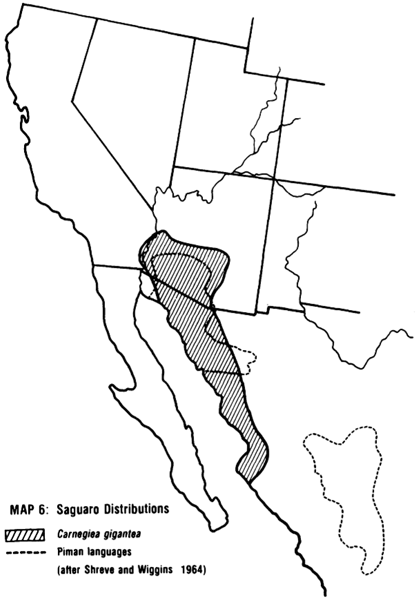 The
Tepiman languages in the southern branch have reconstructible terms
for more desert-like flora and fauna such as the saguaro cactus,
although these languages are currently discontinuous, suggesting
some antiquity to the word.
The
Tepiman languages in the southern branch have reconstructible terms
for more desert-like flora and fauna such as the saguaro cactus,
although these languages are currently discontinuous, suggesting
some antiquity to the word.  Fowler
(1972) argues for this basic split around 3,000 years before the
present (B.P.), i.e. approximately 1,000 BCE.
Fowler
(1972) argues for this basic split around 3,000 years before the
present (B.P.), i.e. approximately 1,000 BCE. 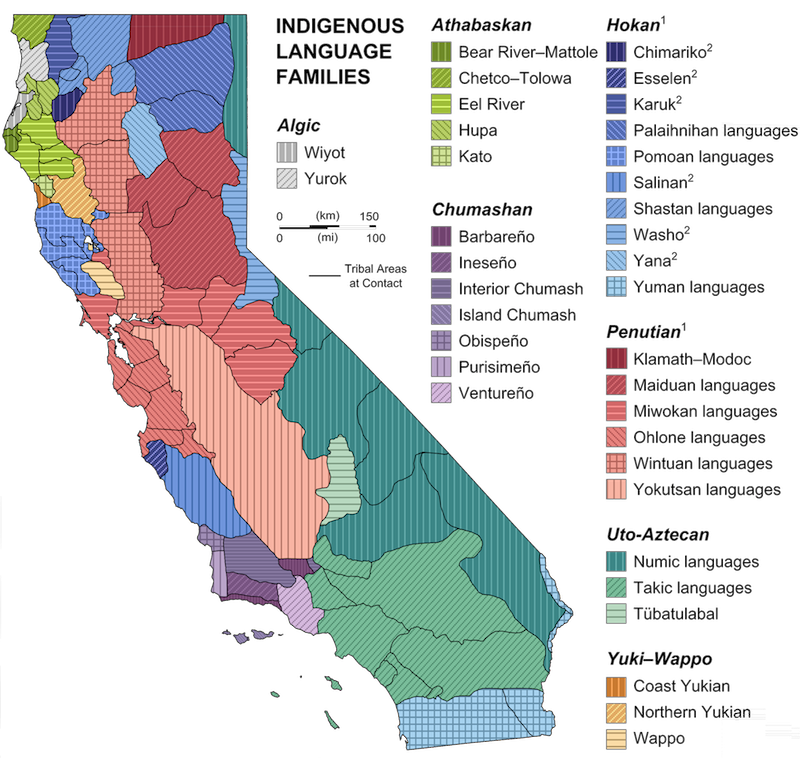
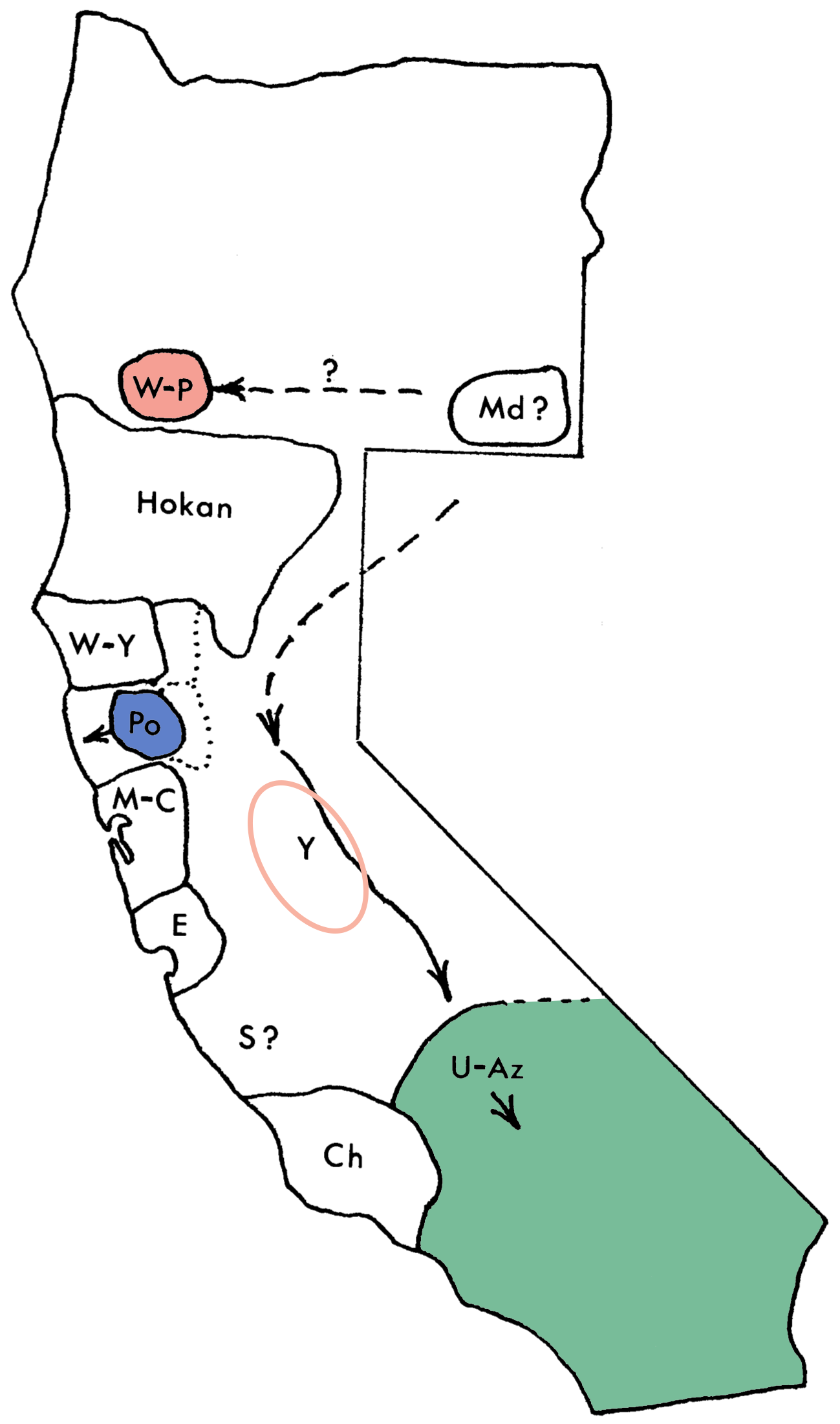 Whistler (1977) gives more detail than the discussion
of Proto-Wintun in the Hinton reading that is based on it. We will look
at his four maps here.
In addition to the linguistic evidence that Hinton suggests, these maps
are also based on changes in local cultural practices (evident in the
archaeological record) that may indicate new populations.
Whistler (1977) gives more detail than the discussion
of Proto-Wintun in the Hinton reading that is based on it. We will look
at his four maps here.
In addition to the linguistic evidence that Hinton suggests, these maps
are also based on changes in local cultural practices (evident in the
archaeological record) that may indicate new populations. 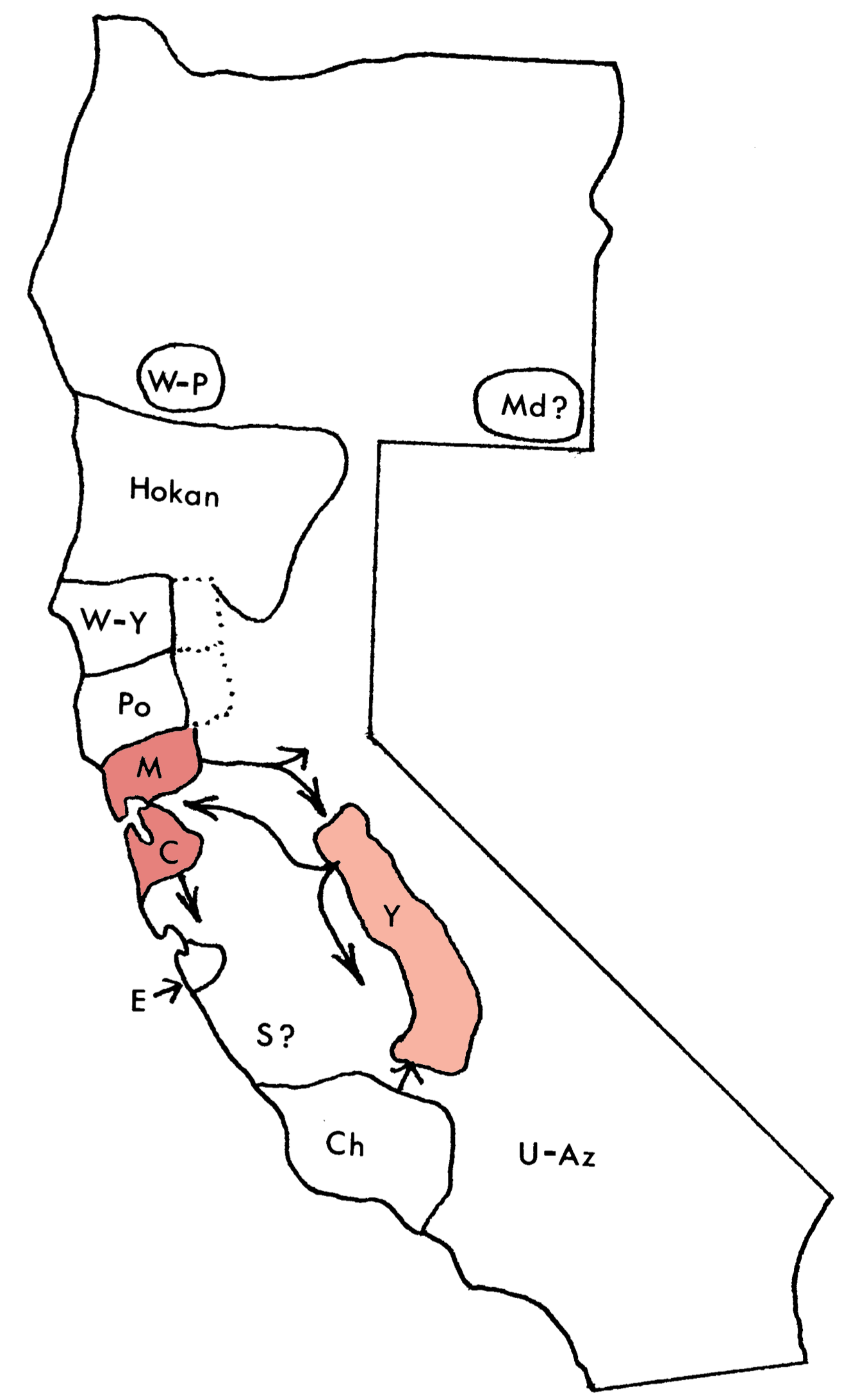 Later
the Yokuts spread further west into the Central Valley and toward
San Francisco Bay. He further suggests the spread of Miwok and Costonoan
languages
(two
clearly related families) from the San Francisco Bay Area to surrounding
areas.
Later
the Yokuts spread further west into the Central Valley and toward
San Francisco Bay. He further suggests the spread of Miwok and Costonoan
languages
(two
clearly related families) from the San Francisco Bay Area to surrounding
areas. Here we see movement of the Algic languages (Yurok and Wiyot) from a
northern location, perhaps the Columbia River gorge or another place
closer to the Algonquian languages.
Here we see movement of the Algic languages (Yurok and Wiyot) from a
northern location, perhaps the Columbia River gorge or another place
closer to the Algonquian languages. 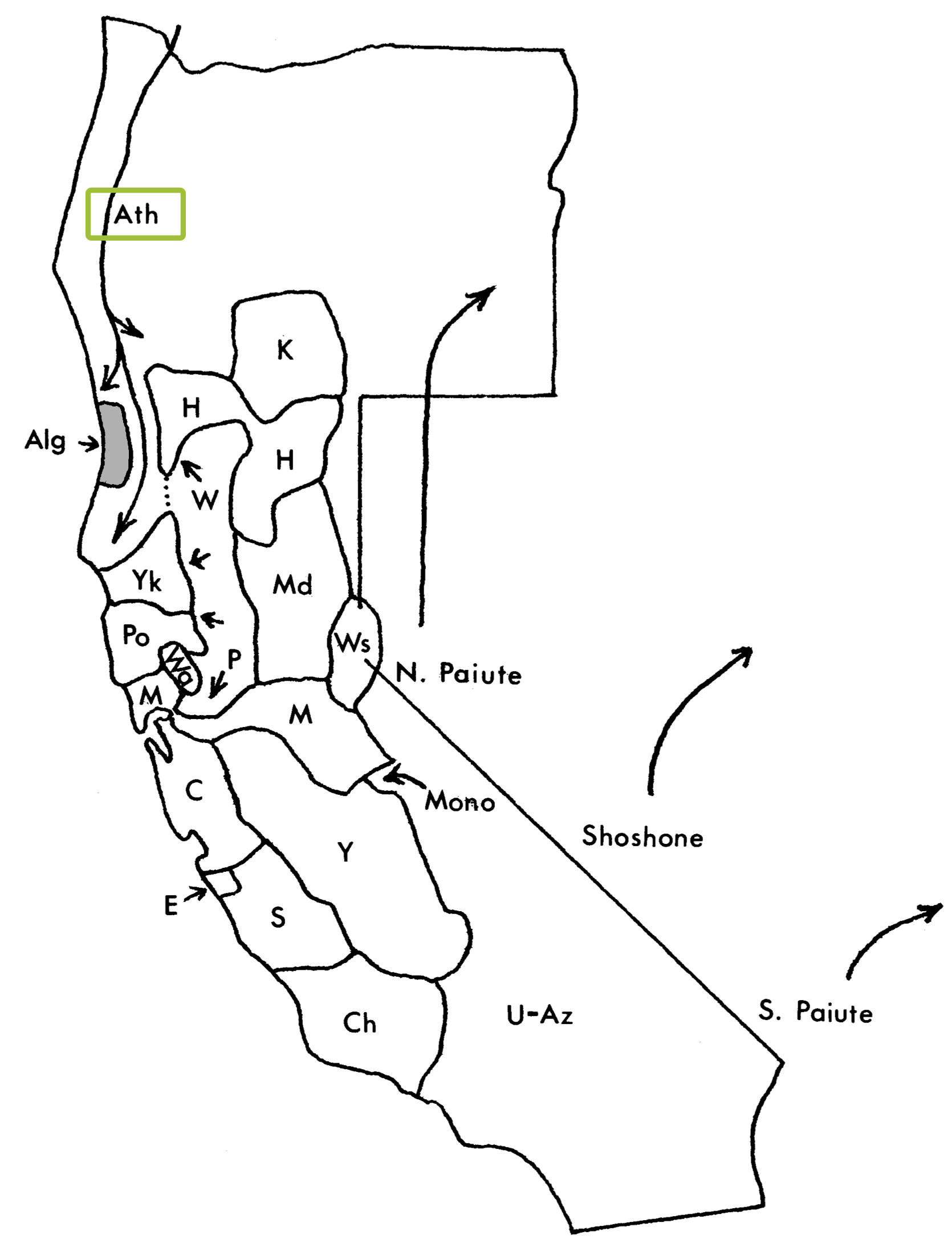 The last major change in the linguistic makeup of California was the
entry of Athabaskan speakers from Canada. They settled on the coast on
either side of the Algic languages, in Southern Oregon and Northern California.
The last major change in the linguistic makeup of California was the
entry of Athabaskan speakers from Canada. They settled on the coast on
either side of the Algic languages, in Southern Oregon and Northern California.